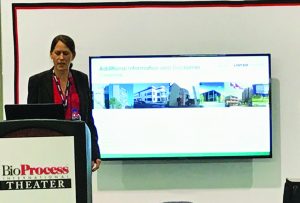 Nina Bauer, associate director of autologous cell therapy commercial development, Lonza Pharma and Biotech
Nina Bauer, associate director of autologous cell therapy commercial development, Lonza Pharma and Biotech
Lonza Emerging Technologies is focusing on cell and gene therapies. Lonza now has expertise in different cell and vector types, constructs, process and assay development, and platform technologies for both clinical and commercial manufacturing. This includes taking a concept through commercial manufacturing.
Lonza just opened a site in Houston, TX, and another in the Netherlands, as well as partnering with Nikon in the Asian market. Cell and gene therapies have a market growth currently of 27% with more than 500 cell and gene therapy companies worldwide developing over 1,300 products. Although Lonza has been focused on large manufacturing of bulk drug substance, the company made a market assessment and came to realize that the market was moving toward patient-specific therapies, specifically with allogeneic and autologous therapies (48% of development pipeline), and has added those to its business.
Autologous (immune cell) therapies, particularly chimeric antigen receptor T-cell immunotherapy (CAR-Ts), have become key therapies in the market. Last year, therapies for blood (liquid) cancers dominated the pipeline, but recently a study was published showing success with a patient going into remission who was treated for solid tumors (1). This was the first success of immune therapy for solid tumors, and the market definitely will be growing.
Even for commercial marketing, that means producing one dose per patient. You cannot scale up, you must scale out. Making small batches with more patients means that you will be making more batches, resulting in more work and more cost, which limits economies of scale. Consider the complexity of a biomanufacturing process for the minimum number of likely patients: for 20,000 patients per year, you need to start 55 new patient processes per day and harvest processes for 55 patients per day, with a 14-day process per patient. So you will have 770 patient processes running in parallel and 495 discrete process actions per day. Processes are very small and must be segregated to prevent contamination. You must have enough physical space to accommodate them, work out the logistics of getting patient samples from a hospital to a manufacturing site, keep clean and sterility considerations in mind, and always remember that you are working for very sick patients.
Bauer shared Lonza’s strategies for making this work. First, she listed the steps (of which everything in bold can be automated): managing incoming documentation to ensure that the correct patient receives the correct end product, whole blood separation, cell seeding, activation, transduction, feeding, washing, process monitoring, selection, concentration, harvesting, release testing, final formulation/cryo preservation, and outgoing documentation. Without automation, those steps would take people 57 hours to do. With automation, labor time is only 16 hours.
Because of those numbers, Lonza is partnering with Canadian company Octane Biotech and using its GMP-in-a-box with Cocoon technology that enables quantity, quality, and cost efficiency. Steps are reduced to getting cells from a patient, cell/tissue input into a vial, use of a disposable cassette and Cocoon instrument, output in vial, and returning the treatment to the same patient after testing. Instead of one cleanroom per patient, you can have one small machine per patient – and the machines are stackable. This process also will reduce site maintenance.
In the future, much work remains to be done on the analytical side for rapid testing. Decentralization also will be an important upcoming factor.
Reference
 1 Zacharakis et al. Immune Recognition of Somatic Mutations Leading to Complete Durable Regression in Metastatic Breast Cancer. Nat. Med. 24, 2018: 724–730. https://www.nature.com/articles/s41591-018-0040-8.
